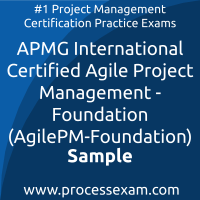 You have to pass the AgilePM Foundation exam to receive the certification from APMG International. To increase the effectiveness of your study and make you familiar with the actual exam pattern, we have prepared this APMG International Agile Project Management Foundation sample questions. Our Sample APMG International Agile Project Management - Foundation Practice Exam will give you more insight about both the type and the difficulty level of the questions on the APMG International AgilePM Foundation Level exam.
You have to pass the AgilePM Foundation exam to receive the certification from APMG International. To increase the effectiveness of your study and make you familiar with the actual exam pattern, we have prepared this APMG International Agile Project Management Foundation sample questions. Our Sample APMG International Agile Project Management - Foundation Practice Exam will give you more insight about both the type and the difficulty level of the questions on the APMG International AgilePM Foundation Level exam.
However, we are strongly recommending practice with our Premium APMG International Certified Agile Project Management - Foundation (AgilePM-Foundation) Practice Exam to achieve the best score in your actual APMG International AgilePM Foundation Exam. The premium practice exam questions are more comprehensive, exam oriented, scenario-based and exact match of APMG International Agile Project Management - Foundation exam questions.
APMG International Agile Project Management Foundation Sample Questions:
01. At the Refinement stage of a structured timebox, what other factors, apart from the MoSCoW priorities, influence the order of work?
a) A sensible development order from a technical perspective
b) Availability of specific resources such as Technical Advisors, Business Advisors
c) Any known cross-team dependencies
d) All of the above
02. How many Management roles are defined in DSDM?
a) 3
b) 4
c) 2
d) 1
03. Between which phases of the DSDM process takes Evolutionary Development place?
a) Between Feasibility and Foundation
b) Between Deployment and Post Project
c) Between Pre-Project and Feasibility
d) Between Foundations and Deployment
04. What best describes a Prioritized Requirements List (PRL)?
a) High-level definition of the tools, techniques and customs
b) High-level prioritized requirements list
c) High-level definition of the over-arching business driver
d) High-level schedule of Project Increments
05. How does DSDM differ from most agile approaches?
a) DSDM agile involves the business in the solution to be developed at an early stage, so that expectations are clear.
b) The approach mainly focuses on the technical feasibility of a project, so there are fewer surprises.
c) DSDM agile is a stripped-down version of other approaches, resulting in fewer roles
d) Less is done for research than in other approaches, so projects start faster and are completed faster.
06. In MoSCoW priotorization, what does the ‘C’ stand for?
a) Could have
b) Can have
c) Cannot deliver
d) Could n’t have
07. Within the foundation phase, DSDM advocates to do:
a) No Design Up Front (NDUF)
b) Big Design Up Front (BDUF)
c) Enough Design Up Front (EDUF)
d) Waterfall approach
08. In which Phase is the purpose to evolve a Solution that meets Business needs?
a) Foundations Phase
b) Evolutionary Development Phase
c) Pre-Project Phase
d) Deployment Phase
09. Who is responsible for decision making during Evolutionary Development?
a) Business Sponsor
b) Business Analyst
c) Business Advisor
d) Business Ambassador
10. Which of the following is NOT a modelling technique, commonly used in DSDM?
a) Storyboards
b) Flowcharts
c) Pie Charts
d) Use case diagrams
Answers:
Question: 01
Answer: d |
Question: 02
Answer: c |
Question: 03
Answer: d |
Question: 04
Answer: b |
Question: 05
Answer: a |
Question: 06
Answer: a |
Question: 07
Answer: c |
Question: 08
Answer: b |
Question: 09
Answer: d |
Question: 10
Answer: c |
If you find any errors or typos in APMG International Certified Agile Project Management - Foundation (AgilePM Foundation) sample question-answers or online APMG International AgilePM Foundation Level practice exam, please report them to us on feedback@processexam.com
 You have to pass the AgilePM Foundation exam to receive the certification from APMG International. To increase the effectiveness of your study and make you familiar with the actual exam pattern, we have prepared this APMG International Agile Project Management Foundation sample questions. Our Sample APMG International Agile Project Management - Foundation Practice Exam will give you more insight about both the type and the difficulty level of the questions on the APMG International AgilePM Foundation Level exam.
You have to pass the AgilePM Foundation exam to receive the certification from APMG International. To increase the effectiveness of your study and make you familiar with the actual exam pattern, we have prepared this APMG International Agile Project Management Foundation sample questions. Our Sample APMG International Agile Project Management - Foundation Practice Exam will give you more insight about both the type and the difficulty level of the questions on the APMG International AgilePM Foundation Level exam.